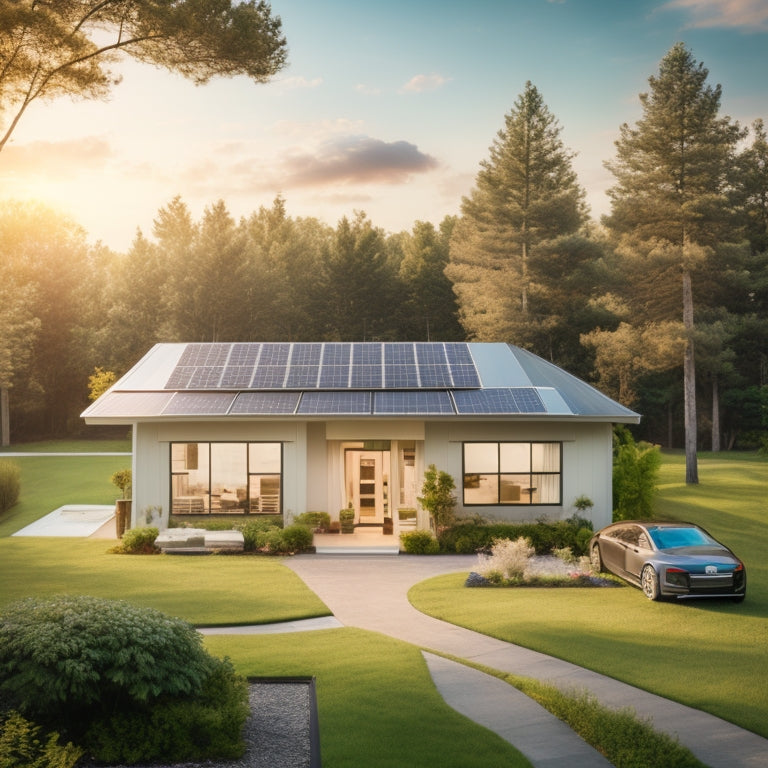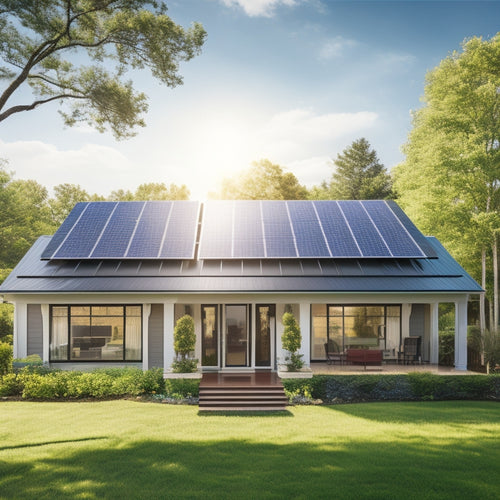
Top Energy Independence Systems for Homeowners
Share
You're taking the first step towards reducing your reliance on the grid and potentially saving thousands on energy bills by exploring the top energy independence systems available. Solar panel systems, energy storage systems, and portable solar power systems are leading options for homeowners. When considering solar panels, look for top brands offering high-efficiency options, and factor in financing options, incentives, and maintenance costs. Combining technologies, such as solar panels with battery storage, can enhance energy resilience. As you evaluate systems, consider your energy needs, budget, and local resources - and you'll be well on your way to achieving energy independence.
Overview
- Solar panel systems offer long-term energy independence and savings, with upfront costs mitigated by financing options and incentives.
- Energy storage systems enhance grid resilience, reduce environmental impact, and provide financial savings through lower energy bills.
- Combining solar panels with energy storage and smart home devices enables optimal energy management and independence.
- Portable solar power systems offer energy independence on-the-go, with high-efficiency panels and power storage options.
- Implementing energy conservation strategies, such as energy-efficient appliances and regular audits, maximizes energy independence value.
Understanding Home Solar Panel Costs
Typically, homeowners contemplating a switch to solar energy are concerned about the upfront costs of installing solar panels.
You're likely wondering if the investment will pay off in the long run. Fortunately, solar financing options can help make the change more affordable. Many providers offer financing plans with little to no down payment, allowing you to start generating clean energy while spreading the cost over time.
In addition, installation incentives like tax credits and rebates can greatly reduce the upfront cost. For instance, the Solar Investment Tax Credit (ITC) allows you to claim a tax credit of up to 26% of the total installation cost.
Moreover, Federal and State Incentives such as the Federal Investment Tax Credit (ITC) and State Rebate Programs can provide additional benefits.
Best Portable Solar Power Systems
When selecting a portable solar power system, you'll need to take into account the solar panel capacity, which determines how much energy you can generate on the go.
High-efficiency monocrystalline panels are recommended for off-grid power, such as the Renogy 400W Kit, which can provide reliable energy harvesting.
The power storage options, such as batteries and inverters, are also essential as they affect the system's overall performance and your ability to use the energy when you need it.
Solar Panel Capacity
Determine your energy needs by evaluating the capacity of your portable solar power system. You'll want to take into account the solar capacity factors, which vary depending on your location and the amount of peak sunlight your panels receive. A higher capacity system can provide more energy, but it also increases the cost and weight of the system.
| System Size | Daily Energy Output | Suitable For |
|---|---|---|
| Small (100W) | 30-40 Ah | Small appliances, chargers |
| Medium (200W) | 60-80 Ah | Medium-sized appliances, laptops |
| Large (400W) | 120-160 Ah | Large appliances, refrigerators |
Power Storage Options
Set up your portable solar power system with a reliable power storage option to guarantee a steady flow of energy whenever you need it. With advancements in battery technologies, you have a range of options to choose from.
Lead-acid batteries are a cost-effective choice, while lithium-ion batteries offer higher energy density and longer lifetimes. When evaluating power storage options, consider the total cost of ownership, including upfront, maintenance, and replacement costs deep cycle capabilities, to ascertain you're making an informed decision.
Consider your energy needs and budget to select the right battery for your system. Effective energy management is essential to optimize your power storage. Look for systems with built-in energy management systems that can monitor your energy usage, detect faults, and provide real-time data to confirm you're always in control of your energy independence.
Top Solar Panel Brands Compared
When evaluating top solar panel brands, you'll want to contemplate two key factors: panel efficiency ratings and system cost analysis.
You'll need to determine which brand offers the highest efficiency ratings, as this will impact how much energy your system can generate.
Panel Efficiency Ratings
Across the solar industry, manufacturers tout their panel efficiency ratings as a key selling point, but what do these ratings really mean for homeowners like you? Panel efficiency refers to the percentage of sunlight that's converted into usable electricity. A higher rating means more energy output per hour of sunlight.
| Panel Technology | Efficiency Comparison |
|---|---|
| Monocrystalline | 20-22% efficient, high-performance panels |
| Polycrystalline | 15-18% efficient, budget-friendly option |
| Thin-Film | 7-14% efficient, flexible and durable |
| Bifacial | 18-22% efficient, captures light from both sides |
Considering installation factors, performance degradation, and environmental impact, it's crucial to weigh efficiency against other factors like warranty options, grid integration, temperature effects, and maintenance requirements. By understanding what panel efficiency ratings mean, you can make an informed decision about the best solar panels for your energy independence pursuit.
System Cost Analysis
You've narrowed down your solar panel options based on efficiency ratings, but now it's time to examine the bigger scenario: the overall cost of the system.
When comparing top solar panel brands, consider the total cost of ownership, including the initial investment, installation incentives, and ongoing maintenance expenses. Financing options, such as loans or power purchase agreements, can also impact your overall cost.
Be sure to factor in local and federal tax credits, which can greatly reduce your upfront costs. Additionally, consider the long-term savings on your energy bills and the potential increase in your home's value.
Benefits of Energy Storage Systems
Several key advantages make energy storage systems a persuasive addition to any home energy independence plan.
By incorporating energy storage, you'll enhance grid resilience and reduce your environmental impact. You'll also reap financial savings through reduced energy bills and potential homeowner incentives.
Energy storage systems provide you with energy security, ensuring you have power when you need it. As technology advancements continue, your system will become more efficient, reducing system maintenance needs.
Additionally, energy storage is a long-term investment, providing you with a reliable source of energy for years to come.
Choosing the Right Solar Inverter
Since your energy independence system relies heavily on solar power, selecting the right solar inverter is imperative to guarantee efficient energy conversion and maximize your system's performance.
You'll need to take into account the different inverter types, including string inverters, microinverters, and power optimizers. Each has its pros and cons, so it's important to weigh your options carefully.
Inverter efficiency is also critical, as it directly affects your system's overall performance. Look for inverters with high efficiency ratings, typically above 95%.
Additionally, evaluate the inverter's compatibility with your solar panel array and energy storage system.
DIY Solar Installation Options
With your solar inverter selected, it's time to contemplate the installation process. You can either hire a professional or take the DIY route.
If you're comfortable with heights and have basic electrical knowledge, DIY solar installation might be for you. You'll need solar installation tools like wire cutters, a multimeter, and a drill.
Rooftop mounting is a vital aspect of DIY solar installation. You'll need to verify your roof is structurally sound and choose a suitable mounting system.
Research local building codes and permits required for your area. Consider online resources and tutorials to guide you through the process.
With careful planning and attention to detail, you can successfully install your solar panel system and start generating your own clean energy.
Maximizing Energy Independence Value
Your solar panel system is now up and running, generating clean energy for your home.
To maximize its value, you'll want to implement energy conservation strategies that reduce your overall energy consumption. This will allow you to optimize your energy independence and get the most out of your solar panel investment.
Take advantage of renewable energy incentives, such as tax credits and rebates, to further increase your return on investment.
By combining energy-efficient appliances and smart home devices with your solar panel system, you'll be able to reduce your reliance on the grid and enjoy the freedom that comes with energy independence.
Frequently Asked Questions
Can I Install Solar Panels on My Old or Damaged Roof?
Before installing solar panels, you'll need a roof condition assessment to guarantee your old or damaged roof can support the added weight and withstand weathering; if not, you may need to repair or replace it prior to solar panel installation.
Will Energy Independence Systems Increase My Property Value?
You'll likely enhance your property value with energy independence systems, as they'll increase your energy savings, which a property appraisal will reflect, ultimately improving your home's worth and your freedom from reliance on external energy sources.
Are Energy Independence Systems Eligible for Government Incentives?
You'll be delighted to know that 30% of the cost of energy independence systems is eligible for federal tax credits, and many states offer additional rebates, incentivizing your shift towards energy efficiency and renewable energy.
Can I Use Solar Power to Charge My Electric Vehicle?
You can charge your electric vehicle using solar power by installing a solar panel system that generates electricity, then connecting it to an EV charger, allowing you to fuel your vehicle with clean, renewable energy.
Do Energy Independence Systems Require Regular Maintenance?
As you flip the switch on your personal energy revolution, remember that your system's reliability hinges on regular maintenance - think of it as oil changes for your car, but less frequent, ensuring your independence from the grid remains uninterrupted.
Ready to Buy
As you stand on the threshold of energy independence, the keys to releasing freedom from the grid are in your hands. Your home, once a mere consumer of energy, is now a self-sustaining powerhouse, radiating like a guiding light of autonomy. With the right systems in place, the sun's rays become a golden thread, weaving together a fabric of savings, sustainability, and true independence.
Related Posts
-

Building an Emergency Backup Solar Power System in 5 Essential Steps
Building an emergency backup solar power system involves five key steps. First, assess your daily energy needs to ide...
-

Top-Rated Home Solar Power Kits for Achieving Energy Independence
Top-rated home solar power kits enable you to achieve energy independence by greatly cutting your energy costs. You c...
-

Home Solar Installation Cost
You're considering installing solar panels on your home, and the upfront cost is likely the biggest hurdle standing i...


